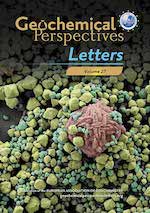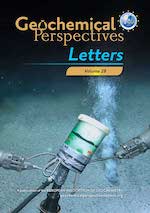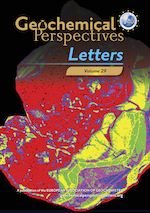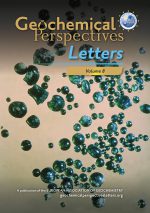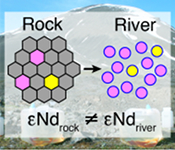 | Decoupling of dissolved and bedrock neodymium isotopes during sedimentary cycling Abstract: The radiogenic neodymium isotope ratio 143Nd/144Nd (expressed as εNd) has been applied to examine seawater elemental budgets, sedimentary provenance, oceanic water mass source and circulation, large scale geochemical cycling, and continental crust growth rates. These applications are underpinned by the assumption that during sedimentary processing the parent/daughter (samarium/neodymium) ratio is conservative during low temperature fluid related processes. In this study, we report εNd data from two streams draining sedimentary formations in the Arctic archipelago of Svalbard. The εNd value of the dissolved load is offset from stream suspended sediment samples by up to 5.5 epsilon units. We demonstrate that dissolved load εNd values are controlled by the dissolution of labile phases present in the catchment rocks which are isotopically distinct from the silicate residue and account for up to 12 % Nd in the bulk sediment. This study highlights; 1) the potential for incongruent release of Nd isotopes to seawater from rocks and sediments, with implications for the isotopic composition of seawater, and 2) the large scale decoupling between a rapidly exchanging labile reservoir and a silicate-bound reservoir during sediment recycling. |
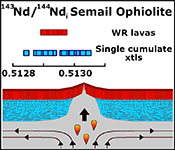 | Isotopic variation in Semail Ophiolite lower crust reveals crustal-level melt aggregation Abstract: The scale and magnitude of compositional heterogeneity in the mantle has important implications for the understanding of the evolution of Earth. Heterogeneity of the upper mantle is often evaluated based on mid-ocean ridge basalt compositions, despite their homogenisation prior to eruption. In this study we present Nd and Sr isotope data obtained by micro-drilling single plagioclase and clinopyroxene crystals in gabbroic cumulates of the Semail Ophiolite (Oman) and show that mantle source variability is better preserved in the lower crust than in the extrusive suite. Analysis of sub-nanogram quantities of Nd in plagioclase revealed a range in 143Nd/144Ndi in the Wadi Abyad crustal section that is three times greater than recorded in the extrusive suite. The isotopic variability is preserved in plagioclase, whereas clinopyroxene is isotopically homogeneous. These data imply that the mantle is heterogeneous on the scale of melt extraction, and that a significant proportion of homogenisation of erupted melts occurs in the oceanic crust, not the mantle. |
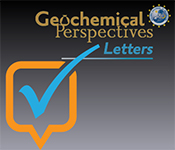 | Erratum to “Noble gases and nitrogen in Tissint reveal the composition of the Mars atmosphere” by Avice et al., 2018 |
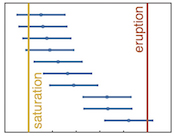 | A stochastic sampling approach to zircon eruption age interpretation Abstract: The accessory mineral zircon is widely used to constrain the timing of igneous processes such as magma crystallisation or eruption. However, zircon U-Pb ages record zircon crystallisation, which is not an instantaneous process. Zircon saturation calculations link zircon crystallisation, temperature, and melt fraction, allowing for the estimation of zircon crystallisation distributions as a function of time or temperature. Such distributions provide valuable prior information, enabling Bayesian estimates of magma eruption time and allowing for comparison of the relative accuracy of common weighted-mean and youngest-zircon age interpretations with synthetic datasets. We find that both traditional interpretations carry a risk of underestimating the uncertainty in eruption age; a low mean square of weighted deviates (MSWD) does not guarantee the accuracy of weighted-mean interpretations. In the absence of independent confirmation that crystallisation timescale is short relative to analytical uncertainties, a Bayesian approach frequently provides the most accurate results and is least likely to underestimate uncertainty. Since U-Pb zircon studies now routinely resolve geological age dispersion due to increasing analytical precision, such considerations are increasingly critical to future progress in resolving rates and dates of Earth processes. |
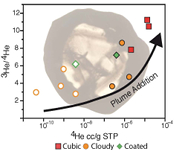 | Plume-lithosphere interaction, and the formation of fibrous diamonds Abstract: Fluid inclusions in diamond provide otherwise inaccessible information on the origin and nature of carbonaceous fluid(s) in the mantle. Here we evaluate the role of subducted volatiles in diamond formation within the Siberian cratonic lithosphere. Specifically, we focus on the halogen (Cl, Br and I) and noble gas (He, Ne and Ar) geochemistry of fluids trapped within cubic, coated and cloudy fibrous diamonds from the Nyurbinskaya kimberlite, Siberia. Our data show Br/Cl and I/Cl ratios consistent with involvement of altered oceanic crust, suggesting subduction-derived fluids have infiltrated the Siberian lithosphere. 3He/4He ranging from 2 to 11 RA, indicates the addition of a primordial mantle component to the SCLM. Mantle plumes may therefore act as a trigger to re-mobilise subducted carbon-rich fluids from the sub-continental lithospheric mantle, and we argue this may be an essential process in the formation of fluid-rich diamonds, and kimberlitic magmatism. |
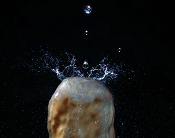 | Transition metal availability to speleothems controlled by organic binding ligands Abstract: Speleothems are important archives of Quaternary palaeoclimate. However, climate proxies based on trace elements in speleothems are currently limited to the metals which exhibit simple partitioning (Mg2+, Sr2+, Ba2+). This study aims to expand understanding of the processes controlling the divalent first row transition metals (M2+) in these systems. Adsorptive cathodic stripping voltammetry was used to determine Cu speciation in speleothem dripwater, stream and pool samples from five limestone caves located in diverse climatic settings. Our results demonstrate that Cu binding and stabilisation by organic ligands (L) is a universal property of cave waters, which decreases the available Cu concentration ([Cu’]) by ~5 orders of magnitude relative to total Cu concentration ([CuT]). Furthermore, [Cu’] does not change meaningfully with increases in either [CuT] or [L], meaning that Cu2+ substitution in Ca2+ valence sites in precipitating CaCO3 speleothems is likely to be inhibited by organic complexation. We suggest that the residence time of speleothem thin water films (1/drip rate), the dissociation rates of labile metal-organic complexes, and the stability of adsorbed (ternary) metal-organic complexes will determine M2+ incorporation in speleothems. |
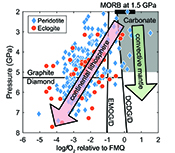 | Redox state of the convective mantle from CO2-trace element systematics of oceanic basalts Abstract: The redox state of mantle lithologies, based on xenoliths from continental lithospheric mantle, has been shown to decrease with depth and reach oxygen fugacities (fO2) at which graphite/diamond will be the stable form of carbon at pressures greater than about 3-4 GPa (e.g., Frost and McCammon, 2008). On the other hand, the depth-fO2 profile of the convecting mantle remains poorly known. We compare the CO2-Ba and CO2-Nb systematics of natural oceanic basalts to the CO2-trace element concentrations that can be generated via contributions from depleted peridotite partial melts and graphite-saturated partial melts of subducted lithologies. Results suggest that to produce the CO2 enrichments relative to the depleted end member observed in natural oceanic basalts, subducted lithologies cannot be graphite-saturated at the onset of melting or must undergo oxidative transformation below the respective volatile-free solidi. Therefore, the oxygen fugacity profile of the continental lithospheric mantle may not be applicable to the deep convecting upper mantle, with the convecting upper mantle to at least 150 km depth being more oxidised than the carbonate vs. graphite/diamond buffer. |
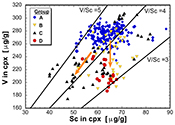 | Influence of metasomatism on vanadium-based redox proxies for mantle peridotite Abstract: The multi-valence nature of vanadium means that its geochemical behaviour will be ƒO2-dependent, so that its concentration or V/Sc (or V/Ga), can serve as proxies for oxidation state in mantle peridotites. Compared to Fe3+/Fe2+-based equilibria, such trace elements may be less sensitive to metasomatic processes. To investigate these systematics, we have measured V, Sc, Ga and Fe3+ contents in clinopyroxene from well-characterised spinel peridotite xenoliths from the Massif Central, France. These samples were metasomatised by a variety of agents with different oxidation states.V contents can be modified by metasomatic interactions, and other geochemically similar elements including Sc and Ga can also be added, removed or remain constant. A link between V/Sc and Fe3+-Fe2+ equilibria is apparent. Partial removal of V is caused by different metasomatic agents; the common factor is that all agents were significantly more oxidised than the initial ambient mantle peridotite. This extraction can be understood by a decreasing partition coefficient for V for ΔlogƒO2 > ~FMQ-2. Considering that mineral/melt partitioning of V decreases similarly for all peridotite minerals, the bulk-rock V/Sc will also change during relatively oxidising metasomatic interactions and mirror the results obtained for clinopyroxene. |
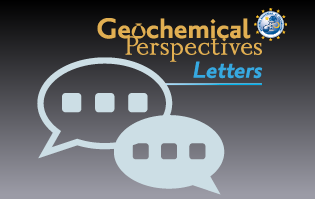 | Reply 2 to Comment on “Ultra-high pressure and ultra-reduced minerals in ophiolites may form by lightning strikes” We appreciate the comments by Yang et al. (2018) to our recent proposal (Ballhaus et al. 2017) that high pressure and ultra-reduced minerals in ophiolites may form by lightning strikes. We have carried out additional experiments to address the issues raised by Yang et al. (2018). We maintain that the ultra-reduced phases in ophiolites are best explained as plasma precipitates generated by lightning strikes. |
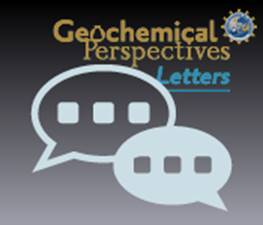 | Comment 2 on “Ultra-high pressure and ultra-reduced minerals in ophiolites may form by lightning strikes” We read with great interest the paper by C. Ballhaus and coauthors (2017) reporting on electrical discharge experiments that showed how SiC and other phases found in mantle-derived rocks can potentially form by lightning strikes (Ballhaus et al., 2017). The experiments are technically innovative and challenging and the results make fascinating reading. In a comment paper, Griffin et al. (2018) noted several lines of evidence that ultra-high pressure (UHP) and super reduced (SuR) minerals in ophiolites do not form by lightning strikes. Here, we add additional comments relating to the geological and mineralogical data from ophiolites that are not compatible with the model of Ballhaus et al. (2017). |
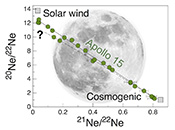 | Apollo 15 green glass He-Ne-Ar signatures – In search for indigenous lunar noble gases Abstract: Identifying indigenous lunar noble gases in samples returned by the Apollo and Luna missions is highly challenging because contributions from the solar wind (SW) and/or cosmogenic nuclides have modified the noble gas signature of the regolith and rocks exposed to space at the lunar surface. Here we re-investigate the possible presence of indigenous noble gases in pyroclastic Apollo 15426 green glasses based on precise measurements of He-Ne-Ar isotopic compositions and abundances. The noble gas content of single glass beads varies by two orders of magnitude, indicating that they experienced highly variable irradiation histories as a result of intense regolith stirring by impact gardening. Four out of the twelve spherules stand out by having the highest He-Ne-Ar abundances and by releasing an isotopically 'solar-like' noble gas component at high temperatures. While a contribution from indigenous noble gases cannot be ruled out, the data are best accounted for by inward diffusion of, and equilibration with, SW-derived volatiles during prolonged space exposure. |
<< Previous issueNext issue >>


